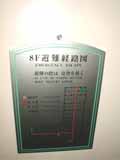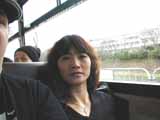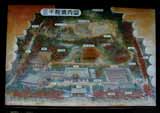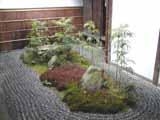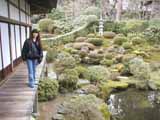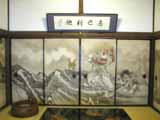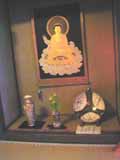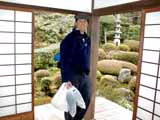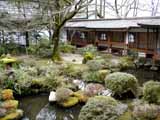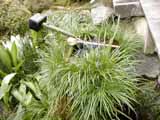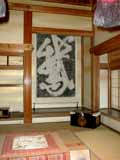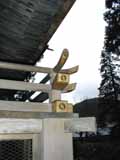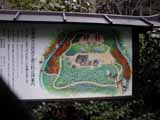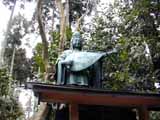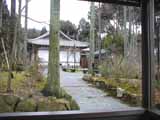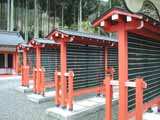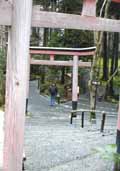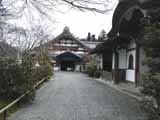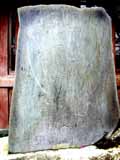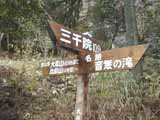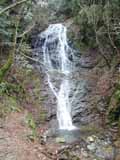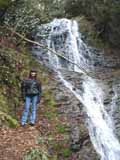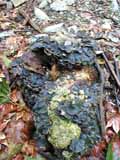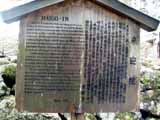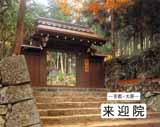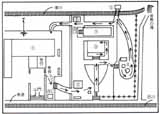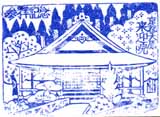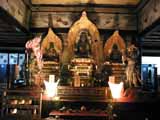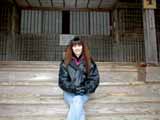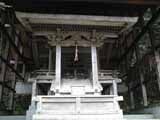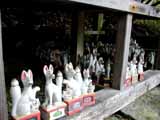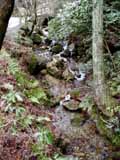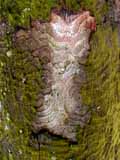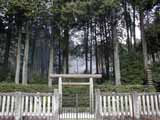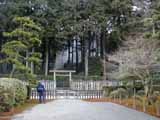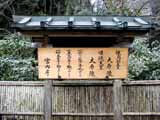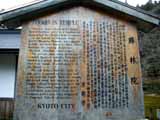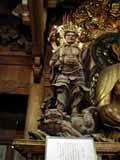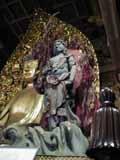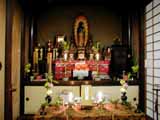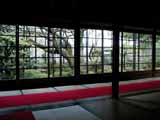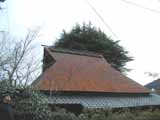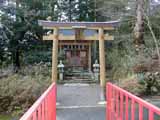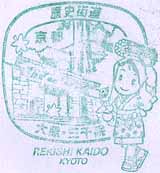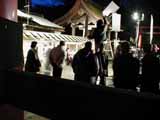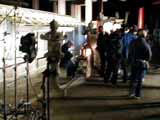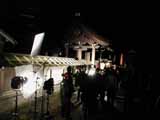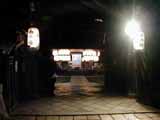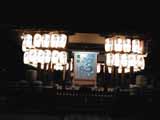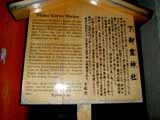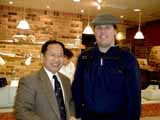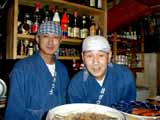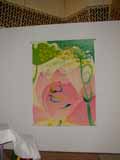We had hoped to get an early start on today's sightseeing and hiking,
but the combination of vacation lethargy and a big morning meal at the
hotel meant that we didn't get out on the road until past 10 am. That,
and the lengthy lunch shopping expedition in the underground grocery store.
After waiting ten minutes or so at the bus station, we climbed onto the
bus bound for Ohara (about an hour's ride), and Ting promptly fell asleep.
Note the fare-sign at the front of the bus. You enter the bus from the
rear, pulling off a ticket from the dispenser by the door. When you get
off, you calculate your fare by matching the number on your ticket to the
number displayed on the fare-sign.
Arriving in Ohara, we hopped off the bus and crossed the road, following
the dotted path marked on the map. It was a cold grey day, maybe 50 or
55 degrees out, but the sky was brightly lit, so we didn't expect it to
rain continuuously like yesterday. In ancient times, Ohara was highly regarded
as a holy site by followers of the Jodo school of Buddhism, but today it
is a sleepy farming town, nestled in the mountains. Most of the shops along
the road to Sanzenin were closed, but a few were open, and we added some
fresh-baked crackers and sugared lemon-peel to our lunch-stash. After about
ten-minutes walk uphill, we reached Sanzenin, the largest of the temples
in Ohara.
Sanzenin was founded over a thousand years ago by Saicho, one of
the revered patriarchs of Japanese Buddhism, to house an image of Yakushi
Nyorai, the Buddha of Healing. After buying our tickets at the entrance
booth, we were handed plastic bags for our shoes. Clad in stocking feet,
we began our trek through the temple. We started in the Reception Hall
of the Abbot's Quarters and followed the tatami mat path from room to room
and building to building, stopping to admire the art and take pictures
of the more striking pieces. Many of the rooms were opened to the outside
via sliding shoji doors, so it was rather chilly inside.
In the hondo, or main altar room, also known as the Ojo Gokuraku-in,
or Temple of Rebirth in Paradise, two monks sat writing out prayers
and supplications, wrapped in warm blankets. This hall was originally constructed
in 985 A.D., and renovated in 1143 A.D. It is presently the oldest temple
building in Ohara. The walls and ceilings were once covered with bright
scenes of Amida's paradise, but the paintings have been considerably darkened
by centuries of inscense and smoke, and so were only dimly visible. In
the Amitabha trinity, the central statue of Amida was completed in 986
A.D., while the kneeling attendant boddhisattvas, Seishi (god of wisdom)
and Kannon (with the lotus) were completed later. All three statues were
constructed of cedar blocks, fitted together, then clothed and lacquered
in gold. After spending a few minutes to contemplate the marvelous altar
while sharing the warmth from their kerosene heaters, we exited the temple
building and put our shoes back on while perched on the steps leading into
the gardens.
The garden grounds were quite serene, as there were only a few gardeners
and a half-dozen other visitors there to appreciate the scenery. Statues
had been placed hither and thither in strategic spots, while an artifically
constructed koi pond meandered in a large loop leading out away from the
main buildings.
Unfortunately, the shrine with the gold-leaf lintels was closed up
-- no doubt because there were so few visitors at this time, so we could
only guess what treasures we missed out on!
Climbing a short stairway up to the upper gardens, we paused for
a moment before the statue of the goddess of music and found ourselves
serenaded by a warbling songbird. Following the more gradual path, we walked
through the forest to the far side of the temple grounds and found an open-walled
shelter housing a weathered stone statue of Amida Buddha that dated back
to the founding of the temple in approximately 800 AD. Beyond the shelter,
the walls of the narrow valley closed in, enfolding a swift stream that
roughly marked the boundary of the temple grounds.
We stood a moment or two on a small footbridge that straddled the
stream, listening to the gurgling rush of the water and watching the occasional
leaf or stick tumbling its way towards the ocean. As it had begun to drizzle,
we headed back towards the center of the temple grounds and soon found
an open-air shelter complete with broad, square picnic table-benches, upon
which we decided that despite the cold, it was time for lunch!
From our shelter we could look over at a newer set of temple buildings,
or down the valley at the stone buddha, or out across the valley cleft
at the bright red bridge we had just visited. We munched on our fish-filled,
sea-weed wrapped rice-balls, and decided then and there that the wrap-it-yourself
balls that came from the deli cooler with plastic-sealed seaweed were much
tastier than the somewhat soggy pre-wrapped rice-balls that came from the
gourmet section of the grocery store. Bananas, crunchy peas, candied ginger
and sugared lemon peel formed the second course for this lunch. By the
time we were finished, we were both pretty cold.
We headed over to the temple shown in 1P, hoping to find another
shrine warmed by kerosene heaters, but the building was closed up. After
a quick jaunt uphill to view the memorial temple (and over 10,000 two-inch
tall buddha icons, all neatly arranged on racks, with plenty of room for
more), we descended back through the garden, past the goddess of music,
through the row of torii gates and right up to the souvenir stalls, where
friendly vendors were handing out hot tea as an incentive to come shopping.
It was outside the 'offical' vending booth that we noticed the stamp-pad
and several rubber stamps...our introduction to the peculiar custom of
collecting rubber or wood-block imprints to show that one has visited various
Japanese pilgrimage-sites. Although we weren't prepared with a proper stamp-book,
the monk inside the stall was more than happy to sell us a packet of Sanzenin
postcards (shown at left), along with a nice white bag that was just right
for stamping!
Exiting the temple and descending back to the street, we decided
to skip the shops that offered food and souvenirs outside, figuring that
we would be warm from the hike up to Otonashi no Taki (Soundless) Falls.
Following the Ro River, the road gradually became narrower and narrower,
while the pavement grew increasingly cracked and fragmented until we reached
the trailhead sign. At this point, the crumbling road turned right, crossed
the river and continued on an isocline, while a dirt trail meandered up
the hillside. We followed the trail, reasonably confident that it would
take us to our goal, sometimes walking along the river, other times leading
us off under the trees.
After about ten or fifteen minutes of gradual ascent, we reached
the falls. It was hard to imagine the fuss of the legend (that the falls
were so loud that they drowned out the chanting of the monks at nearby
Raigoin). On the contrary, it was peaceful, and the cascade of water tumbling
downhill was entrancing. We stayed until it began to drizzle again, which
signified that it was time to move under the canopy of the trees and walk
back down into Ohara.
Stopping at Raigoin, about halfway back into town, we found the temple
deserted except for a few monks walking from one building to another. Raigoin
was founded a little under a thousand years ago as a school for monks to
learn buddhist chanting. Although we didn't see any singing choruses, at
various times during our visit there we could hear the monks practicing
from within closed temple buildings.
After buying our tickets and collecting a fresh stamp for our new
collection, we walked over to the main temple building, where a small shoji
window had been opened to allow us to look inside at the statues of the
main altar. From left to right, the three central images are Y(?), Amida
(sp) and Sakyamuni. Standing as guardian on the left is a statue of Fudo
Myoo, on the right is Bishamonten. We walked through the gardens and stopped
for another picture at the stone pagoda marking the resting place of the
temple founder, Ryonin.
Exiting the temple grounds, we retraced our steps along the road
beside the river, passing several small, unmarked shrines or temples, and
walking downhill until we reached Sanzenin, whereupon we turned and continued
past the main gate to reach the smaller temples further along the road.
The first shrine we reached was open, but the sign lacked an English translation,
so we could not relate the name. The gate at the road opened up into an
austere gravel garden that led up to a second gate standing before a small
forest. On both sides of the gravel garden, budding rhododendrons and azaleas
hinted that spring would arrive soon. Beyond the second, closed gate, smoke
or incense wafted through the trees, accompanied by the sound of chanting
monks. We spent a few minutes peering into the forest, trying to see whether
the smoke came from a building or an open fire, but the density of both
smoke and trees prevented us from seeing the source of the fragrant smoke.
Back on the road, Ting posed for a picture just before we reached
the next temple, Shorinin. Apparently we had regained the main pilgramage
route, as there were at least four other visitors walking the grounds when
we arrived. Like many of the other temples, Shorinin was only dimly lit
and no photographs were allowed inside the temple. Ting tried to be subtle
with the camera by not using the flash. Unfortunately, the shot of the
Eleven-headed Amitabha was just impossible without one, so she quickly
flipped on the flash for that one picture (silently apologizing to the
Buddha for the intrusion) just before another pair of pilgrims entered
the temple. Without the flash, the camera shuttle stayed opened longer
to let in more light, but it also made for fuzzier pictures if one could
not hold the camera still long enough. Either that or the main Buddha simply
did not want to be photographed, so we had to settle for the grainy image
that's the basis of the filtered picture in the set at left. You can partially
see the magnificently serene central buddha in the photo of the fierce-looking
right-side guardian.
Our next stop was Hosenin. From the roadside, Hosenin appeared to
be a residence, since it lacked a large hondo, but we were attracted by
the description in our guidebook, which noted two interesting facts about
this small temple. The first is that the gardens are dominated by a 700+
year-old white pine tree said to be shaped like Mount Fuji. The second
is that the ceiling had been built from timbers salvaged from the floor
of Fushimi castle following the dramatic defeat of samurai forces of the
first shogun, Ieyasu, in a battle against the imperial army. Rather than
burning the wood, sections of the castle floor were sent to four temples
in the area around Kyoto, to be used in the construction of new buildings
so that the wood may be purified by the rising incense, and the souls of
the deceased warriors may be assuaged by the perpetual recital of prayers
by the monks and priests.
Again, aside from the denizens of the temple, we were alone. After
paying our entrance fee, the priestess/hostess ushered us in to a nice
spot in the deserted teahouse from where we could observe both the gardens
and the small shrine adjacent to the tearoom. She returned very shortly
after seating us with two frothy cups of kampucha (green tea) and small
Japanese cakes, and then left us alone to contemplate our surroundings.
As it was still chilly outside, the hot tea, though bitter, was welcome
warmth for both our hands and our tummies.
Several minutes after we had finished the tea, the priestess returned
and ushered us to the outer perimeter of the tearoom (visible as the red-carpeted
area in the two photos). With a slim staff in her hand, she then began
to point out the stains in the ceiling made by the blood of the fallen
samurai. Although the images were quite faint in the dim light, once your
eyes managed to catch a contour or two, incredible amounts of detail would
fill in. In several cases the wood recorded the agonizing grimace of a
samurai's final moment when he toppled face foward after commiting seppuku.
Other images showed the outline of limbs, or bloody handprints and knee
prints. Partway through our 'tour' of the ceiling, a priest came and took
over, pointing out new sights such as stains that revealed the patterns
of the warrior's clothing and armor. Despite the ghoulish nature of the
imagery, it was quite fascinating!
Upon reaching the far end of the room, the priest opened up a shoji
screen and led us onto a deck that looked out on another side of the garden.
He pointed out a pair of terrapins nestled in the reeds of the small koi
pond, then motioned us over to a group of small 2-3" diameter pipes leading
up from the pond and through the deck to a height of a foot or so. Bending
over, he put his ear down close to a pipe and then paused for a moment
as a beatific smile spread across his face. Taking our turns to listen,
what we heard was a faint tinkle of bells accompanying the melodig gurgling
of water sloshing in the pipes. An aquaphone! Cool!
Leaving Hosenin behind, we then tried to find Jikkoin, but the guide
book map (reproduced at the top of the page) didn't quite seem to match
the layout of paths or roads. Instead, we contented ourselves with looping
back towards the bus station along a narrow footpath threading between
the fields and an irrigation canal. At one point the path led back to a
junction with the road, marked by a cluster of farmhouses with elegantly
rusted rooftops. If you look carefully at photo (7), you'll notice two
interesting things. First is the satellite dish peeking over the lower
right corner of the roof -- things were not necessarily so rustic on the
farm after all! Second is the black 'dai' character on the left-facing
eave of the upper wall.
A little further down the road from the farmhouses we stopped on
a red iron bridge to take a picture of one more small shinto shrine before
returning to the footpath. Another ten minutes walk and we had finished
our descent into the village. Seeing a bus at the station, we hustled back
the last few hundred meters, but it turned out that we needn't have rushed,
as the bus was closed up and the driver off on a break. After a few minutes
waiting, the driver returned so that we could board. We picked out a pair
of seats located strategically above one of the heating vents.
It grew dark as the bus returned to Kyoto. While Ting napped, I played
solitaire on my Palm V and tried to guess the best stop for finding Shin
Shin Do, the coffeehouse and bakery owned by our friend Taro Tsuzuki's
family. Although he could not give us the exact address, Taro had indicated
that the main shop was located near Kyoto University, somewhere close by
the intersection of Kawaramachi-dori and Imadegawa-dori. We disembarked
at Mikage-bashi and crossed over the Takano-gawa to head towards that landmark.
As we passed by Shimogamojinja, we could not help but notice extra
bright lights illuminating the trees from below and police or security
guards standing along the road to wave on traffic or direct selected vehicles
into a lot humming with generators. Crossing the road to investigate, we
walked past all sorts of equipment trucks and luxury cars to find a scene
being filmed before a side gate to the temple grounds. The two characters
we saw were an elderly gatekeeper, visible in the first two pictures, and
a heavily made-up woman dressed in fine silk. As we watched, they filmed
several takes, each no longer than 30 seconds. In between takes, assistants
would rush up to the two cast members and apply more makeup, offer hot
tea or warm towels, or adjust the lighting to bring more or less illumination
to the scene depending on the director's orders.
Standing in the cold to watch the film captivated us for only a few
minutes however. We soon exited the temple grounds and continued on to
Shimogamo-hondori where we turned left and walked down to Aoyobashi (sp)
to cross over the Kamogawa. As a bitterly cold wind blew down the course
of the river, we were glad to reach the cover of the close-built structures
on the far side. Noticing a koban (I think it's the blue sign at the intersection
marked Aoyobashi-Mitsuke), we entered to ask directions to Shin Shin Do.
The older policeman eating roast chestnuts and sitting by the heater inside
the door didn't seem to understand my broken Japanese, too well, but a
strapping young officer entered a minute later, and after a moment, he
understood my request and pulled out a city map. He pored over it for a
few minutes, then studied my tourist map and traced the route to the coffeeshop
with his finger. We thanked him for his help and then continued on our
search.
As we walked down Teramachi-dori towards our goal, we passed along
the outside of the imperial palace, as well as several temples, shrines,
schools and other sights. Many were closed, but surprisingly, some were
open, even brightly lit. An example of one such place is the Shi Mogoryo
Jinja, shown in several pictures at left. According to the policeman's
directions, we were to turn left into the first street following this shrine,
then right at the next corner. Arriving in the right neighborhood and turning
onto the correct street, we were a little doubtful, as things seemed pretty
well closed up for the night. Fearing that we had gone astray, we stepped
into a shoe store as the owner was closing down and asked for help again.
Much to our relief, he pointed to a store front across the street and half
a block down. Success!!
We rushed over and found two workers busy putting away pastries and
cleaning up to go home for the night. I did my best to explain that we
were friends of Taro and following a telephone call, they asked us to wait
a few minutes. Before we had time to complete our survey of the baked goods,
Taro's cousin Hajimu arrived, and we were able to convey greetings from
America! We talked for a few minutes and updated Hajimu as to Taro's current
email information, then presented him with a kleines geschenk, a CD of
Soli Deo Gloria from last summer's show in Berkeley. After a few more minutes
of conversation, Hajimu excused himself to get back to the office to finish
up the day's paperwork. Happy to have attained another goal, we determined
that it was time to look for a dinner spot.
Somehow we ended up in a covered arcade -- the route shown on the
map for this next section is only approximate at this point -- and as we
continued our search for the right place to eat, Randy was distracted by
a large rack of hippie clothes topped by a "40% off" sign. At first glance,
it appeared that the rack held only the usual assortment of ill-made cotton
shirts from India and brightly colored rayon shirts from Indonesia common
to deadhead vendors in the states. Upon closer look, however, Randy noticed
several fine looking flannel jackets from Nepal, and after a bit of choosing,
had selected one and taken it inside to try on.
The tiny shop was no more than twelve feet wide and twenty feet long,
and it was absolutely packed from the floor to the rafters with all the
usual stuff: clothes in racks along one wall, hats, beanies, wallets, bags,
purses, eyeglass cases, backpacks, bedspreads and other cloth items piled
up on tables and shelves in the center, and jewelry, statues and other
items in cases and shelves along the other wall. There was hardly enough
room for either one of us to navigate the aisles, but Randy squeezed his
big belly past all the fragile items without breaking anything, and found
enough room in back by the mirror to decide that the flannel jacket he
had picked out was just right. After completing the purchase, we offered
the proprietor a choice of CDs, and he eagerly snatched up the JGB disc
once he noticed it among the offerings. Before leaving, we asked the proprietor
for a restaurant recommendation, and after thinking a few minutes, he drew
a quick map and sent us out to find the Ing Bar.
The Ing Bar turned out to be one of many small bars/restaurants in
the Ponto-cho district lining the narrow roads that run parallel to the
Takasegawa and Kamogawa rivers. Without the recommendation, we would never
have picked it out, as the bar was up on the second or third floor of a
building that had some eight to ten restaurant/bars, in a block that had
at least a dozen similar buildings. Upon walking in, we were a little dubious,
as the only people inside were the two crew members behind the bar, but
they answered affirmatively when we asked about getting food, so we sat
down facing them in the middle of the bar. The restaurant was really teensy
-- probably less than 400 square feet total -- and the only seating was
at the half-dozen or so stools at the bar, or at the two small tables squeezed
into an alcove behind the bar (and barely visible in the picture of us
seated at the bar).
Unfortunately, the bar didn't have a menu (!), but through a combination
of shot-in-the-dark requests on our part and show-and-tell pantomime on
the part of the crew members, we were able to eat a hearty, homestyle meal
of soup, vegetables, fish and rice, served in a series of small courses,
much like eating tapas. As the stereo was shuffling through a succession
of jazz discs, Randy offered the crew members a CDR of the Marilyn Crispell
- Gerry Hemmingway duo from Yoshi's in 1995. Although they were quick to
pop the new CD into the player, we could tell by their quizzical expressions
that they weren't all that familiar with the spaced-out style of avante
garde jazz that is Marilyn's forte. A man walked in and starting smoking
up a storm at the end of the bar. Literally getting smoked out in the cramped
space, we bid them goodbye with the sound of Marilyn and Gerry crashing
around merrily in the background. Outside, it looked as if things were
picking up as more people were strolling about than when we went in to
eat.
Walking a block or two more down Pontocho-dori brought us to the
main drag of Kawaramachi-dori, where we turned and headed down towards
the Shijo subway station. About halfway there, we stopped and crossed the
street to check out another street-side shrine, this one at Shinyogoku-dori.
Unfortunately, like so many other sights, this one was left out of our
Kyoto guidebook, and the only signage was in Japanese, so we'll remain
ignorant about its name for now.
After taking the subway back down to the main railway station, we
wandered back through the underground mall towards our hotel. Everything
was pretty much closed up, though a few of the bars, restaurants, and coffeeshops
were still open. We stopped to take a picture of the nice Buddha painting
that had been added to the art display set up in one of the open areas,
then continued on back to the hotel for some well-earned rest.
|


